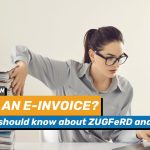
In today’s digital world, e-invoices are becoming more and more standard. They save time, reduce paper consumption and simplify the accounting process. However, despite these benefits, there are some stumbling blocks that often occur when creating e-invoices. In this blog post, we take a look at the most common mistakes and give you tips on how to avoid them. Read this blog to create an e-invoice correctly.
#1 Incorrect or incomplete information
Incorrect or incomplete information is a common problem when creating e-invoices. These include, for example
- Incorrect invoice number: Every invoice must have a unique and consecutive invoice number. A duplicate or missing invoice number can lead to accounting problems and legal consequences.
- Incomplete address details: Make sure that both your own address details and those of your customer are correct and complete. An incorrect address can lead to delays in payment.
- Missing mandatory information: In Germany, certain details are required by law, such as the invoice date, the service period and the VAT identification number. The lack of this information can jeopardize the validity of the invoice.
The mandatory details of an e-invoice do not generally differ from those of a regular invoice. For the XRechnung, for example, the routing ID must also be specified.
#2 Incorrect calculation of value added tax
Another common error is the incorrect calculation of VAT. This can happen if the wrong tax rate is applied or if taxable sales are not reported correctly. As the e-invoice only applies to the B2B sector and is only intended for Germany, at least tax-free transactions are not among the potential sources of error.
Correcting an e-invoice is no more time-consuming than correcting a digital invoice. Of course, canceling and reissuing is possible, but can be avoided with perfect preparation.
#3 Incorrect formatting
Although there are different formats for e-invoices, such as XML (XRechnung) or PDF with embedded XML file (ZUGFeRD), it is important to choose the right format for your specific requirements. A common mistake is to send e-invoices in a format that cannot be processed by the recipient. This leads to unnecessary delays and increases the administrative burden.
Talk to the recipient of your invoice and ask for the desired format. Avoid complications in the invoice delivery process and, above all, for the payment of your service.
#4 Nicht konforme Rechnungssoftware
Viele Unternehmen verwenden spezielle Software zur Erstellung von E-Rechnungen. Ein häufiger Fehler ist es jedoch, nicht konforme Software zu verwenden, die nicht den gesetzlichen Anforderungen entspricht. Dies kann dazu führen, dass Ihre Rechnung nicht akzeptiert wird. Es ist daher wichtig, regelmäßig Updates durchzuführen und sicherzustellen, dass Ihre Software den aktuellen Standards entspricht.
Oder aber Sie suchen nach einer Cloud-Lösung wie easybill, bei denen Updates jederzeit im Hintergrund erfolgen, ohne dass Sie von Einschränkungen betroffen sind oder sich aktiv um Updates bemühen müssen.
#5 Insufficient archiving
The archiving of e-invoices can also lead to problems. In Germany, invoices must be stored for ten years. It must be ensured that the e-invoices are stored in an unalterable format and are accessible at all times. A common problem is inadequate data backup, which can lead to data loss in the event of a system failure.
easybill archives all tax-relevant documents for you in accordance with the applicable retention periods. In accordance with GoBD requirements, documents cannot be deleted.
#6 Lack of validation
Before an e-invoice is sent, it should be checked carefully. A common mistake is to send the invoice without validation, which can lead to errors. Automatic validation using special software can help to detect and correct errors at an early stage.
In this case too, easybill users score points. This is because it is not possible to complete the e-bill without all the mandatory information. The system deliberately draws your attention to missing information so that you cannot make a mistake in this area. Don’t worry at all!
Use easybill to rule out errors
There are many advantages to creating e-invoices, but there are also numerous pitfalls to avoid. By observing the above points, you can ensure that your e-invoices are correct, complete and legally compliant. This will help you avoid delays in payment and unnecessary complications, and any necessary corrections to the e-invoice can also be avoided.
It is worth investing time and effort in the careful creation and checking of e-invoices – because in the end it pays off in smoother business operations. What’s more, outstanding support is also important in the event that questions do arise. For many entrepreneurs, e-invoicing is a new step and unfamiliar territory. So why not rely on a professional who has been supporting e-invoices since 2020? You can get tips for error-free e-invoices from us at any time.
Read also:
The best e-commerce marketplace for your business? easybill compares the most popular platforms
Your optimal preparation and support thanks to the easybill eBook e-invoice
Create e-invoices in ZUGFeRD 2.2 format (German Help Center)



